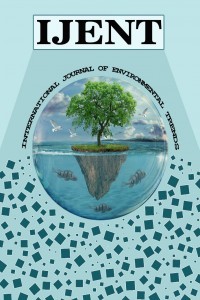Evaluation of Hazardous Wastes in Terms of Occupational Health and Safety, and Environmental Ethics
Evaluation of Hazardous Wastes in Terms of Occupational Health and Safety, and Environmental Ethics
Considering the two concepts of environment and human from a historical point of view, they are two interconnected formations that cannot be separated from each other, and which have influenced each other throughout history. The purpose of the article is to evaluate the concept of "environment" in which many living beings and non-living objects can affect each other endlessly, and humans who have an organic connection with the environment since its existence, develop biologically and socially due to this bond, and who used the environment throughout its development and dragged this "environment" to extinction with the destruction it has created. It will also be narrowed these concepts and try to evaluate the sub-headings of occupational safety in terms of people in business life, and hazardous waste management, which is not very ecocentric in terms of the environment and companies. Furthermore, it is tried to evaluate the results in the scope of environmental ethics, which has almost no impact on working life conditions
___
- [1] Narter, S. (2015). Occupational Accident and Legal and Criminal Liability in Occupation. Ankara: Adalet Yayınevi.
- [2] Kalyoncu, G. (2007). Turkey’s Accesion to the European Union. Occupational Health and Safety. Yüksek Lisans Tezi, Ankara Üniversitesi/Sosyal Bilimler Enstitüsü, Ankara
- [3] LaGrega, M.D., Buckingham, P.L., Evans, J.C., 2001. Hazardous waste management, 2nd ed. McGraw-Hill, Boston, MA.
- [4] Http://www.basel.int/convention/about.html ,2009.
- [5] Occupational Safety Law No. 6331, T.C. The Official Gazette, Issue: 28339, June 30, 2012.
- [6] Waste Management Regulation, T.C. Official Gazette, Issue: 29314, April 02, 2015.
- [7] Salihoğlu, G. (2019). Hazardous Waste Management. Türkiye Bilimsel ve Teknolojik Araştırma Kurumu.
- [8] Amerbauer, M. (1998). Erste Schritte in der Philosophie. Einheit 6: Angwandte Ethik.
- [9] İğci, T, Çobanoğlu, N. (2019). An Assesment of Climate Change and Global Agreements from the Perspective of Environmental Ethics. Ankara Üniversitesi Çevrebilimleri Dergisi 7(2), 130-146 (2019).
- [10] Demir, B, A. (2020). A New Relationship with The Earth: Biocentrism and Deep Ecology. Felsefe Arkivi - Archives of Philosophy, Sayı/Issue: 52, 2020.
- [11] Akkoyunlu Ertan, K. (1998). Enviromental Ethics. Amme İdaresi Dergisi, 31(1), 125-139.
- [12] Kinney, G.F., Wiruth, A.D., (1976), “Practical risk analysis for safety management”, NWC Technical publication 5865, Naval, Weapons Center, China Lake CA, USA, 1976.
- [13] Birgören, B. (2017). Calculation Challenges and Solution Suggestions for Risk Factors in the Risk Analysis Method in the Fine Kinney Risk Analysis Method. International Journal of Engineering Research and Development, Issue:1 Volume: 9.
- [14] Sectoral Waste Guidelines, Metal Sector. Republic of Türkiye Ministry of Environment, Urbanization and Climate Change Broadcast.
- [15] Sectoral Waste Guidelines, Paint/Varnish. (2016). Republic of Türkiye Ministry of Environment, Urbanization and Climate Change Broadcast.
- [16] Köse, N. (2016). Applications of TS-EN-ISO 14001Enviromental Management System and TS-18001 OHSAS Occupational Health and Safety Management System in The Example Of TPAO. Msc. Thesis of Namık Kemal University Graduate School of Natural and Applied Sciences Department of Enviromental Engineering.
- ISSN: 2602-4160
- Başlangıç: 2017
- Yayıncı: Muhammed Kamil ÖDEN
Sayıdaki Diğer Makaleler
Investigation of the retention of oils mixed with water by forming activated carbon added nanofibers
Mustafa KARABİLGİN, Emine AĞAÇAYAK, Berra Gül SAFRAN, Merve AĞAÇAYAK, Tevfik AĞAÇAYAK
THE CONCEPT OF PUBLIC AESTHETICS FROM ENVIRONMENTAL LAW
THE EFFECT OF BEET (Beta vulgaris) JUICE SOLUTIONS ON SECRET Icing
Evaluation of Hazardous Wastes in Terms of Occupational Health and Safety, and Environmental Ethics
